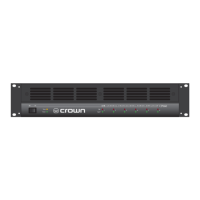Page 18
CP660 Six Channel Amplifier
Reference Manual
5.2 Solving Output Problems
High-frequency oscillations can cause your amplifier
to prematurely activate its protection circuitry. The ef-
fects of this problem are similar to the RF problems de-
scribed in Section 5.1. To prevent high-frequency
oscillations:
1. Bundle together each pair of loudspeaker conduc-
tors when using long cable runs or when different
amplifiers use a common cable tray or jacket. (Do
NOT bundle wires from different amplifiers.) This
reduces the chance of conductors acting like an-
tennas to transmit or receive the high frequencies
that can cause oscillation.
2. Avoid using shielded loudspeaker cable.
3. Never tie together input and output grounds.
4. Never tie together the output of different amplifiers.
5. Keep output cables separated from input cables.
6. Install a low-pass filter in series with each input
(see Section 5.1).
7. Install the input wiring according to the instructions
in Section 3.3.2.
Another problem to avoid is the presence of large infra-
sonic currents when primarily inductive loads are
used. Examples of inductive loads are 70-volt trans-
formers and electrostatic loudspeakers.
Inductive loads can appear as a short circuit at low fre-
quencies. This can cause the amplifier to produce large
low-frequency currents and activate its protection cir-
cuitry. Always take the precaution of installing a high-
pass filter in series with the amplifiers input when
inductive loads are used. A three-pole, 18-dB-per-oc-
tave filter with a –3-dB frequency of 50 Hz is recom-
mended (some applications may benefit from an even
higher –3-dB frequency). Such a filter is described with
infrasonic frequency problems in Section 5.1.
Another way to protect inductive loads from large low-
frequency currents and prevent the amplifier from pre-
maturely activating its protective systems is to parallel a
590 to 708 µF nonpolarized motor start capacitor and a
4-ohm, 20-watt resistor in series with the amplifier out-
put and the positive (+) transformer lead. This circuit is
shown in Fig. 5.2. It uses components that are available
from most electrical supply stores.
4 ohm, 20 watt
Resistor
590 to 708 µf Capacitor
120 VAC, N.P.
+
–
Inductive
Load
+
–
From
Amplifier
Output
Fig. 5.2 Inductive Load (Transformer) Network

